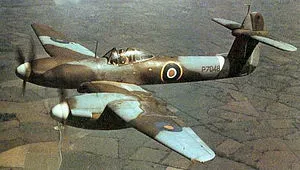Whirlwind (Total: 9, Canadian: 9, Group 0)
Westland Whirlwind

Westland Whirlwind in a rare Second World War colour photograph
The Westland Whirlwind was a British twin-engined heavy fighter developed by Westland Aircraft. A contemporary of the Supermarine Spitfire and Hawker Hurricane, it was the first single-seat, twin-engined, cannon-armed fighter of the Royal Air Force. When it first flew in 1938, the Whirlwind was one of the fastest combat aircraft in the world and with four Hispano-Suiza HS.404 20 mm autocannon in its nose, the most heavily armed. Protracted development problems with its Rolls-Royce Peregrine engines delayed the project and few Whirlwinds were built. During the Second World War, only three RAF squadrons were equipped with the aircraft but despite its success as a fighter and ground attack aircraft, it was withdrawn from service in 1943.
Despite the Whirlwind's promise, production ended in January 1942, after the completion of just 112 production aircraft (plus the two prototypes). Rolls-Royce needed to concentrate on the development and production of the Merlin engine, and the troubled Vulture, rather than the Peregrine. Westland was aware that its design "“ which had been built around the Peregrine "“ was incapable of using anything larger without an extensive redesign. After the cancellation of the Whirlwind, Petter (head of Westland design team) campaigned for the development of a Whirlwind Mk II, which was to have been powered by an improved 1,010 hp Peregrine, with a better, higher-altitude supercharger, also using 100 octane fuel, with an increased boost rating. This proposal was aborted when Rolls-Royce cancelled work on the Peregrine. Building a Whirlwind consumed three times as much alloy as a Spitfire.
The Whirlwind was most often used in ground-attack missions over France, attacking German airfields, marshalling yards, and railway traffic. The Whirlwind was used to particularly good effect as a gun platform for destroying locomotives. The aircraft was also successful in hunting and destroying German E-boats which operated in the English Channel. At lower altitudes, it could hold its own against the Bf 109. Though the Peregrine was a much-maligned powerplant, it was more reliable than the troublesome Napier Sabre engine used in the Hawker Typhoon, the Whirlwind's successor. The twin engines meant that seriously damaged aircraft were able to return with one engine knocked out. The placement of the wings and engines ahead of the cockpit allowed the aircraft to absorb a great deal of damage, while the cockpit area remained largely intact. The rugged frame of the Whirlwind gave pilots greater protection than contemporary aircraft during crash landings and ground accidents. Wikipedia
Whirlwind serial P6987
s/n P6987
Westland
P 6987
Known Units: ;263
last update: 2025-December-20
Whirlwind serial P6989
s/n P6989
P 6989
Known Units: ;263
last update: 2025-December-20
Whirlwind Mk. l serial P6995
s/n P6995
Westland
P 6995
Known Units: ;263
last update: 2025-December-20
Whirlwind serial P7036
s/n P7036
Westland
P 7036
Known Units: ;137
last update: 2025-December-20
Whirlwind serial P7043
s/n P7043
Westland
P 7043
Known Units: ;263
last update: 2025-December-20
Whirlwind Mk. l serial P7058
s/n P7058
Westland
P 7058
Known Units: ;137
last update: 2025-December-20
Whirlwind serial P7103
s/n P7103
Westland
P 7103
Known Units: ;137
last update: 2025-December-20
Whirlwind serial P7114
s/n P7114
Westland
P 7114
Known Units: ;137
last update: 2025-December-20
Whirlwind serial P7122
s/n P7122
Westland
P 7122
Known Units: ;137
last update: 2025-December-20
